GuitarPlayer Verdict
Three affordable, vintage-spec, cool-looking guitars with great playability.
Pros
- +
Jazzmaster: Sounds amazing either clean or overdriven
- +
Telecaster: An affordable vintage-spec Tele with
- +
great playability and tones
- +
Mustang: Cool look. Nice playability and range
- +
of tones
Cons
- -
Mustang: The Vibrato arm easily comes loose
You can trust Guitar Player.
Fender’s recently introduced Vintera II series features classic colors, accurately replicated pickups and period-correct neck shapes. Produced in Fender’s Ensenada, Mexico, factory, the line comprises Stratocasters and Telecasters from the ’50s, ’60s and ’70s; a ’50s Jazzmaster; ’70s Jaguar and Mustang models and several basses from the same decades. For this review, I received guitars from three consecutive decades — a ’50s Jazzmaster, a ’60s Telecaster and a ’70s Mustang — which were tested with a trio of Fender amps (a Deluxe Reverb, a ’48 Dual Professional and a Tone Master Princeton Reverb) and several grind pedals, including the new UAFX Lion ’68 Super Lead.
’50s Jazzmaster
Introduced in 1958, the Jazzmaster was presented as a flagship model for jazz players, but when that plan didn’t go as expected, it found a foothold in the 1960s surf scene. Decades later, the Jazzmaster attained its rightful place in the Fender hierarchy via alternative, grunge and indie players of the ’80s and ’90s.
The swanky ’50s Jazzmaster that I received for this review looks ever so sharp in its Desert Sand paint and gold anodized pickguard, and it features a tinted maple neck with a late-’50s C shape, a slab rosewood fingerboard with a 25 ½–inch scale, and 21 nicely worked and polished vintage-tall frets. Bolted to an offset-waist alder body with beautifully rounded curves and a comfy ribcage contour, it has an enticing playing feel, with the factory setup providing low action and tuneful intonation.
Equipped with an adjustable bridge and floating trem, the Jazzmaster stayed in tune under moderate vibrato use, and the soft response of the long bar is really nice. The system has a trem-lock feature that will hold the tuning if a string breaks. When this happens, the plate tilts back from the loss of tension. You simply push the trem bar down, slide the switch back and it will hold the plate level so the guitar plays in tune, even with the broken string. An explanation of how the system works can be found here.
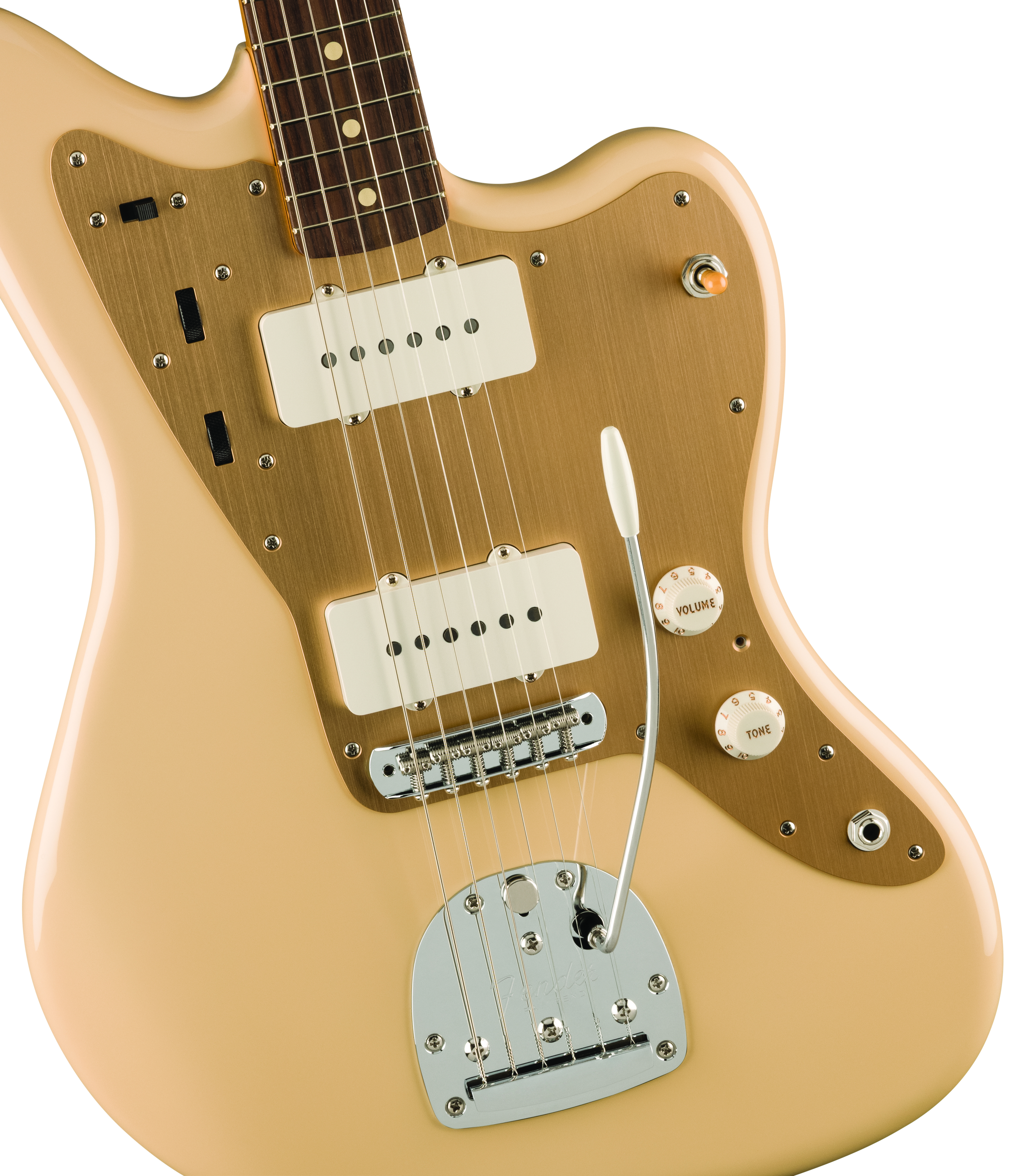
The Jazzmaster’s pair of large single-coil pickups are fairly low output, which can be good for pedal users. They’re complemented by an adventurous control scheme consisting of master volume and tone knobs, a three-way toggle for selecting pickups, and, on the upper bout, a slider switch that activates the neck pickup by itself (which sounds a touch darker in this mode) and volume and tone thumbwheels that let you adjust its sound independently of the other controls. Simply put, it functions like a preset for the neck pickup that can be handy for quickly switching between, say, a gnarly bridge-pickup lead tone and a warm rhythm sound.
The Jazzmaster’s tones are crisp and harmonically vibrant, and the sound with both pickups on is great for rhythm playing — clean or distorted — while the rear pickup delivers a killer lead tone through distortion or fuzz pedals. A Jazzmaster has its jangly charms for sure, and those clean sounds are addictive in their own way, but this sexy guitar can sound mighty too, which is why players like J Mascis, Troy Van Leeuwen, Jim Root and many others are fans of the Fender that’s “jazz” in name only.
’60s Telecaster
The popularity of Fender guitars from the 1960s has lifted the prices of vintage models beyond the reach of many players, so it was cool to receive the very affordable Vintera II ’60s Telecaster that arrived here in a Fiesta Red finish, complemented by a three-ply white pickguard and chrome hardware. The bolt-on maple neck has an early ’60s profile that sits nicely in the hand, and the slab rosewood fingerboard features the traditional 25 ½–inch scale and narrowish 7 ¼–inch radius.
Riding atop are 21 vintage-tall frets with well-attended crowns, smooth tips and a gleaming polish. A good factory setup makes for excellent playability, negligible string buzz and sweet intonation along the gloss-finished neck. The strings load through metal ferrules on the back of the instrument, running across an adjustable three-saddle steel bridge on their way over a smoothly finished nut to the vintage-style, ribbed-back tuners, which are the same types that are used on the Jazzmaster.
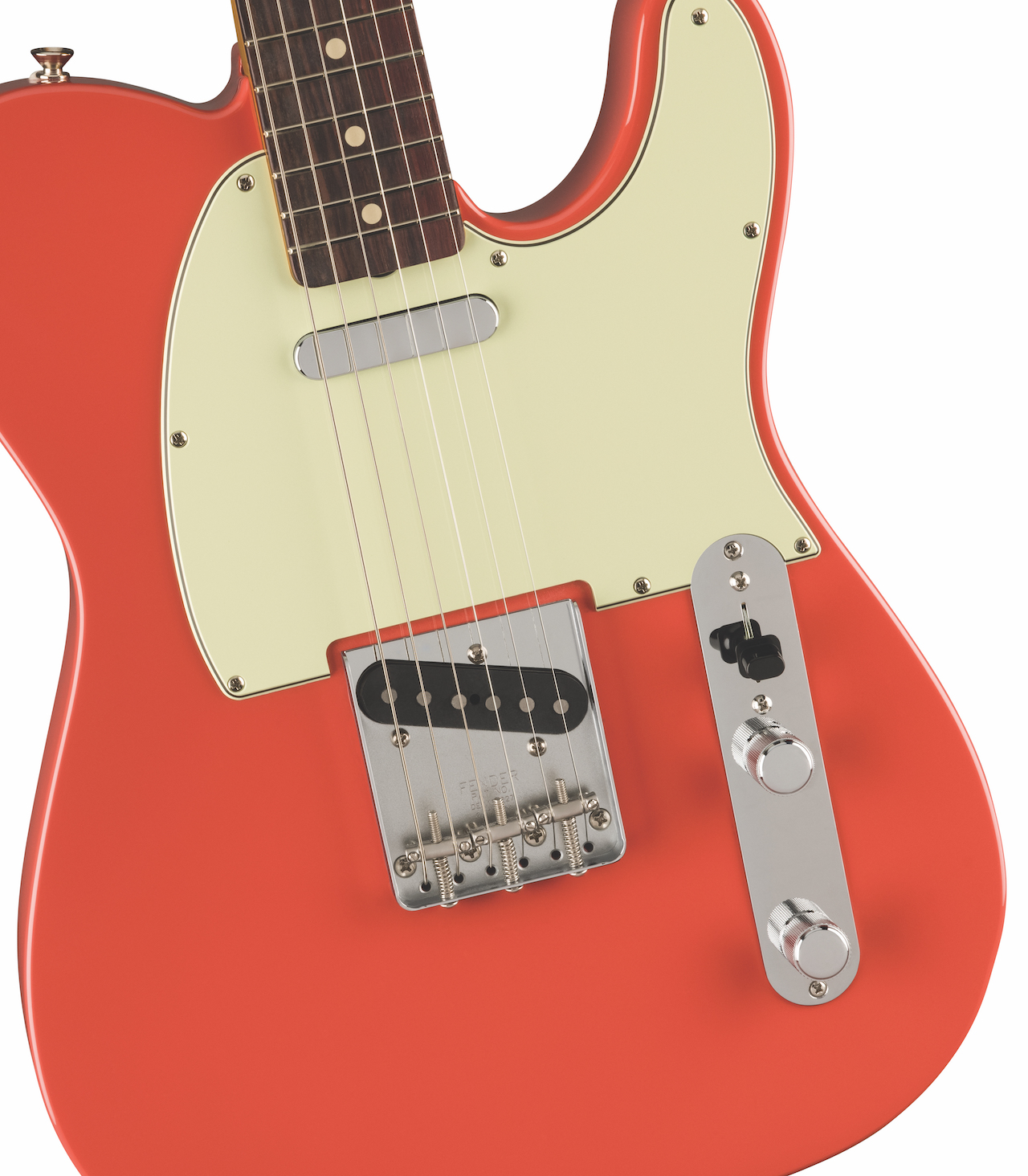
This guitar felt solid and stayed in tune well during my tests, and despite being a bit on the heavy side, at nearly eight pounds, its acoustic voice sounded resonant and sustaining — characteristics that translated nicely into the amplified realm through my Fender test combos. The bridge pickup is fat sounding and packs a steely top end, and sounded badass through distortion pedals or straight into the ’48 Dual Pro, which enhanced everything with its unique flavor of grind and uncanny responsiveness to the guitar volume control. Switching to both pickups yielded tones that were clear and robust, with a touch of phasey color that’s cool for funk riffing.
All in all, the ’60s Telecaster is a supreme working-musician’s guitar that covers a lot of bases, which is why, more than a half century since its introduction, it’s still so popular and continues to remind us just how far ahead of the curve Leo Fender was in 1950.
’70s Mustang
Famed Mustang players include Adrian Belew, Kurt Cobain and John Frusciante, and the model has remained popular with fans of its compact, offset design ever since it debuted in 1964. The Vintera II ’70s Mustang features a Competition Orange finish with white racing stripes (also available in Competition Burgundy), three-ply pearloid pickguard, large ’70s-style headstock, and “F”-stamped neck plate and tuners with white buttons.
In keeping with its original intent to be a compact student model, the guitar has a smaller-proportioned alder body and a bolt-on maple neck with a 24-inch scale rosewood fingerboard wearing 21 nicely finished vintage-tall frets. The C-shaped neck on my review guitar has exceptionally figured maple and sits well in the hand, offering an easy playing feel with rubbery bendability courtesy of the shorter scale.
The Dynamic Vibrato is a cool feature comprising a wraparound tailpiece that rocks in concert with a six-saddle adjustable bridge when pressing down on the bar. Held in place by a set screw (i.e. it’s not threaded), the bar has a tendency to come loose and can even pop right out if you don’t keep the screw firmly tightened. That aside, the unit allowed for aggressive use while keeping the pitch relatively stable once the strings were stretched out.

The Mustang sports a pair of single-coil pickups with black plastic covers; volume and tone pots with black knobs; and a pair of three-position slide switches to turn the pickups on and off individually, with center being off. The sound is loudest and fullest with both switches set toward the neck, and slightly hollower with a bit less output when both are pointed toward the bridge. Set both switches to the inward or outward positions and the sound is funky and out-of-phase.
The pickups sound good on their own, too — the neck position delivers a clear, girthy tone that’s cool for blues when pushing some grind, and it steers into jazzy territory with the tone knob rolled down a bit. The bridge pickup has good output, and its bright, balanced tone sounded great for lead and rhythm through a cranked amp or distortion pedal, where the Mustang cops an aggressive attitude that’s pretty cool given its sort of toy-like demeanor, compared to full-sized Fenders.
Bottom line, the Vintera II ’70s Mustang is a hip guitar for those who appreciate Fender’s outlier compact models.
Specifications: Vintera II ’50s Jazzmaster
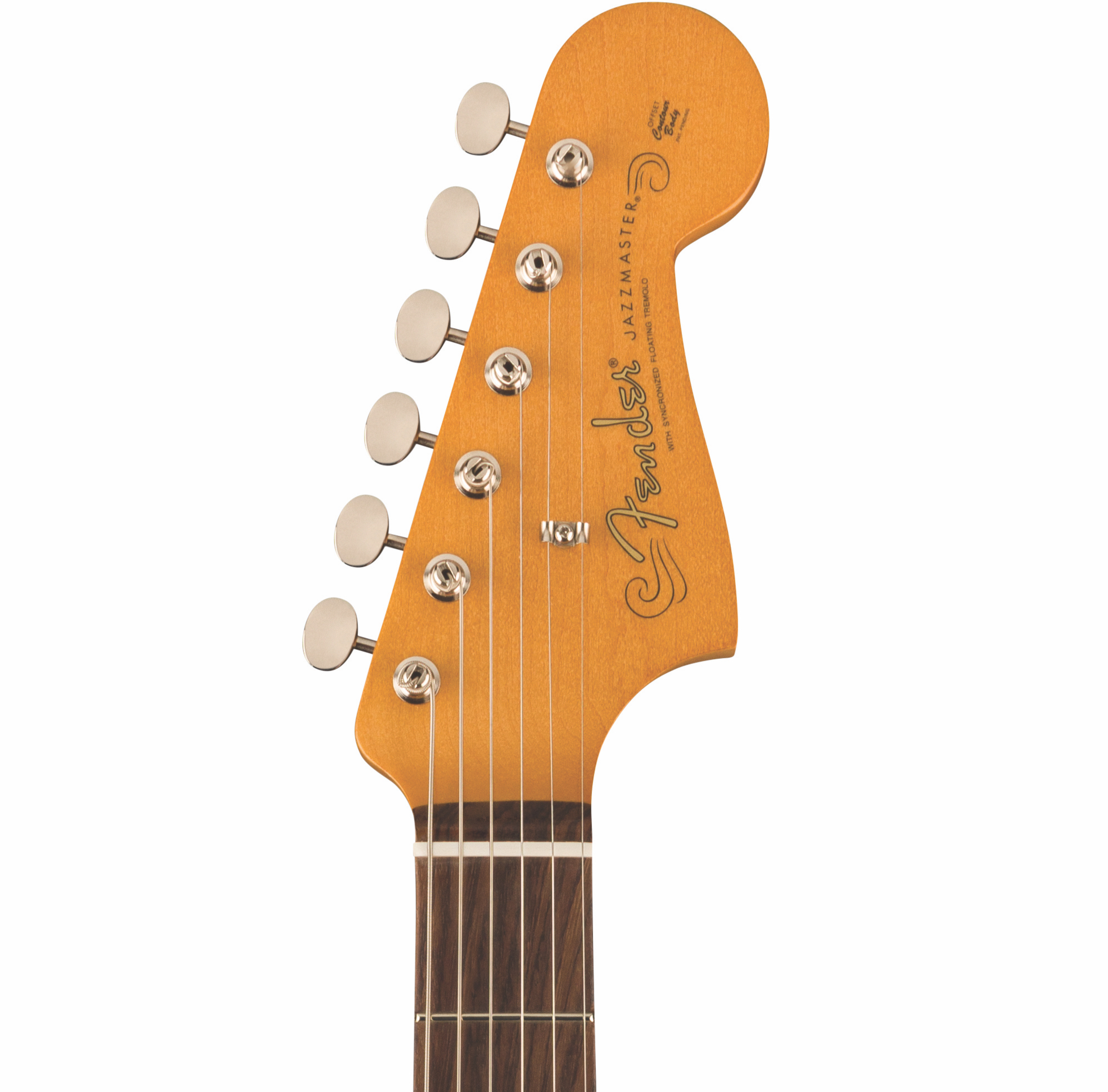
CONTACT fender.com
PRICE $1,249 street. gig bag included
NUT Synthetic bone, 1.650” wide
NECK Maple, late-’50s C profile
FRETBOARD Rosewood, 25 1/2” scale,
7.25” radius
FRETS 21 viintage tall
TUNERS Vintage style
BODY Alder
BRIDGE Vintage-style with adjustable saddles and floating trem
PICKUPS Fender ’50s Jazzmaster single-coils
CONTROLS Master volume and tone, pickup toggle. Thumbwheels for neck volume and tone, slide switch to activate neck pickup only
EXTRAS Available in Desert Sand and Sonic Blue
FACTORY STRINGS Fender 250R .010–.046
WEIGHT 8.4 lbs (as tested)
BUILT Mexico
KUDOS Sounds amazing either clean or
overdriven
CONCERNS None
Specifications: Vintera II ’60s Telecaster
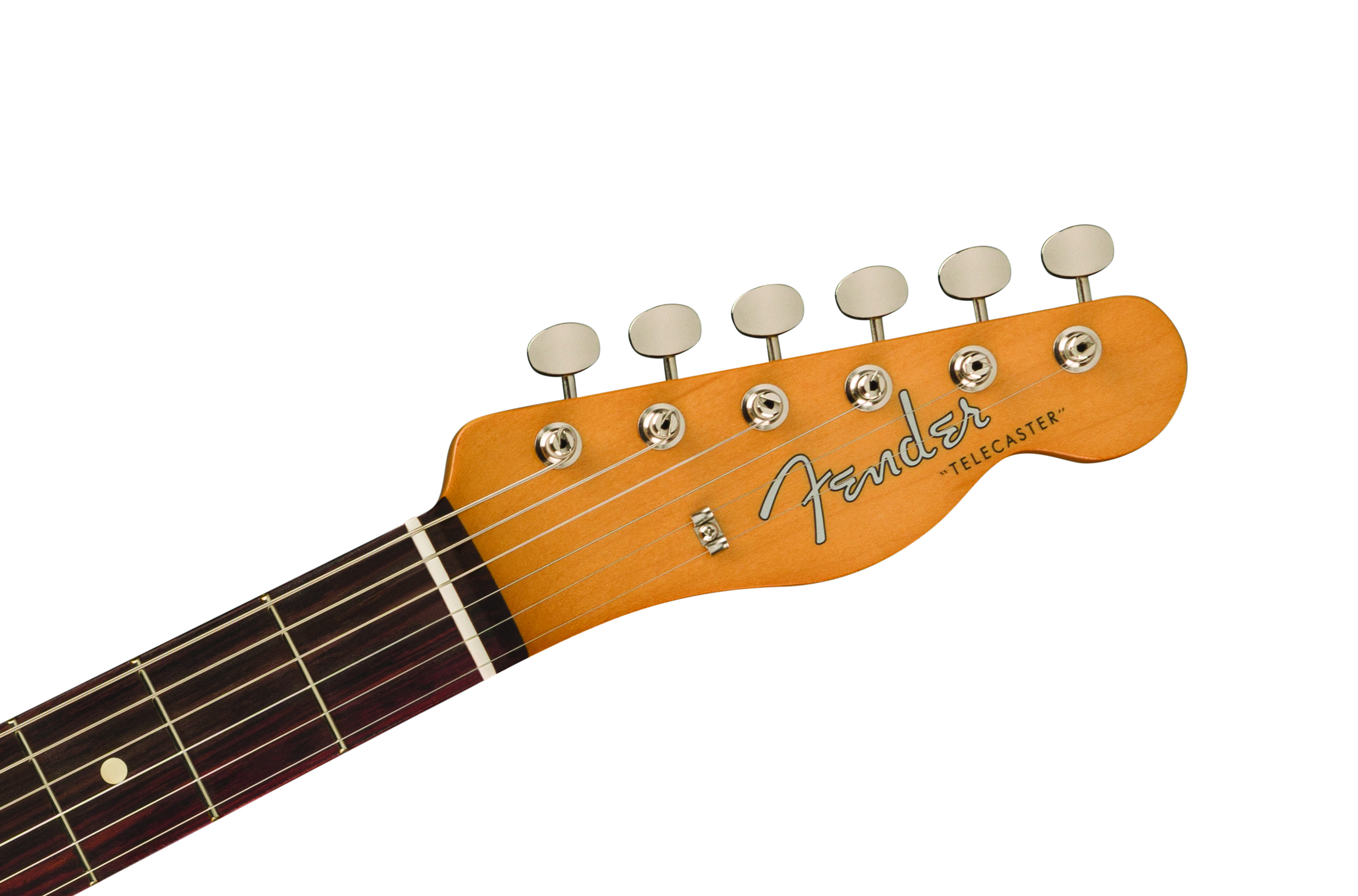
CONTACT fender.com
PRICE $1,149 street, gig bag included
NUT Synthetic bone, 1.650” wide
NECK Maple, early-’60s C profile
FRETBOARD Rosewood, 25 1/2” scale, 7.25” radius
FRETS 21 vintage tall
TUNERS Vintage style
BODY Alder
BRIDGE Three-saddle Vintage-style Tele with slotted steel saddles
PICKUPS Fender ‘60s Tele single-coils, neck and bridge
CONTROLS Master volume and tone, three-way switch
EXTRAS Available in Fiesta Red and Sonic Blue
FACTORY STRINGS Fender 250L, .009–.042
WEIGHT 7.94 lbs (as tested)
BUILT Mexico
KUDOS An affordable vintage-spec Tele with great playability and tones
CONCERNS None
Specifications: Vintera II ’70s Mustang
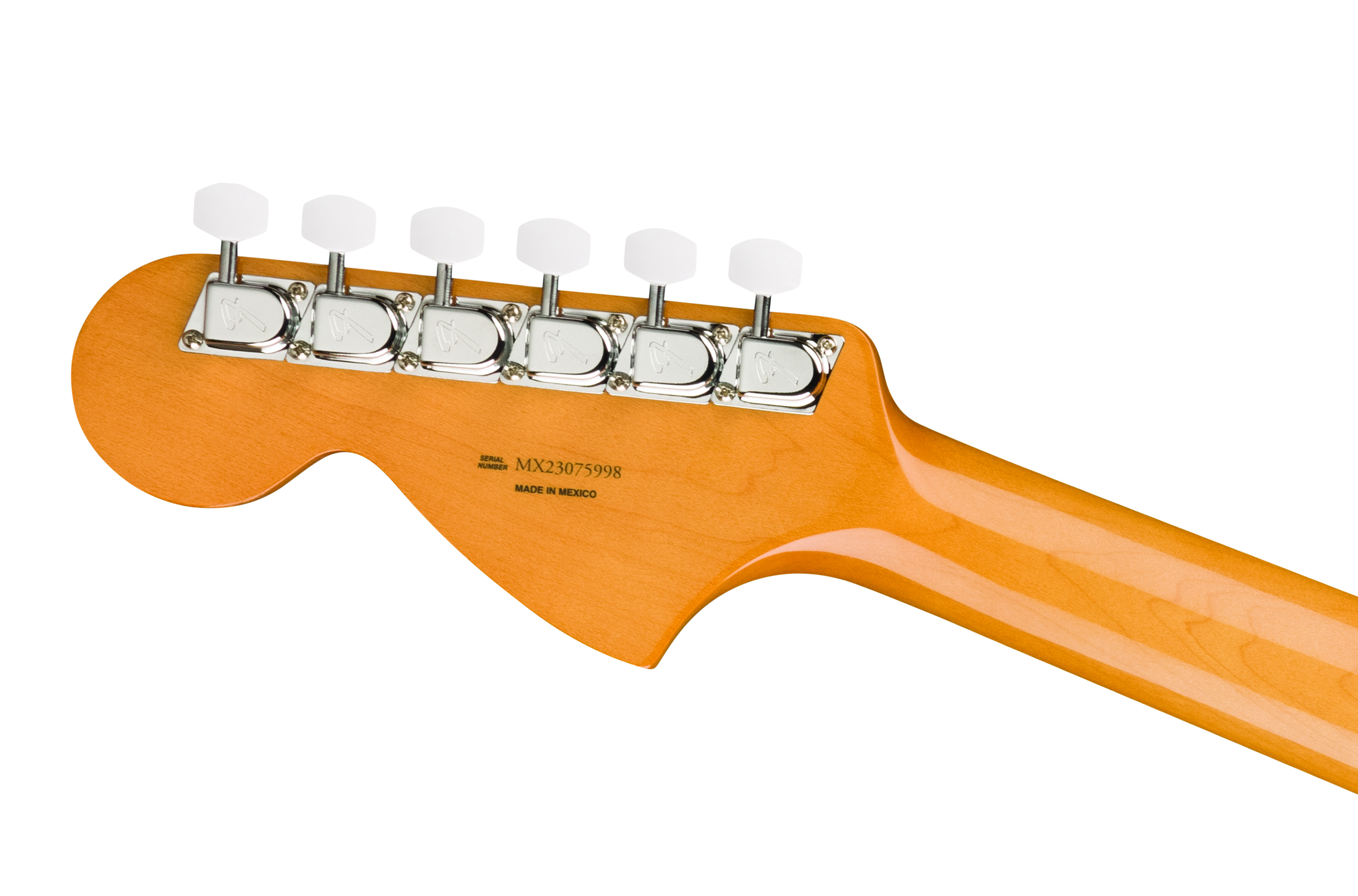
CONTACT fender.com
PRICE $1,149 street, gig bag included
NUT Synthetic bone, 1.650” wide
NECK Maple, ’70s C profile
FRETBOARD Rosewood, 24” scale,
7.25” radius
FRETS 21 vintage tall
TUNERS Fender Vintage F stamped
BODY Alder
BRIDGE 6-saddle Dynamic Vibrato bridge/tailpiece
PICKUPS Fender ’70s Mustang single-coils
CONTROLS Master volume and tone, two three-way switches
EXTRAS Available in Competition Orange and Competition Burgundy
FACTORY STRINGS Fender 250L, .009–.042
WEIGHT 7.52 lbs (as tested)
BUILT Mexico
KUDOS Cool look. Nice playability and range of tones
CONCERNS Vibrato arm easily comes loose

Art Thompson is Senior Editor of Guitar Player magazine. He has authored stories with numerous guitar greats including B.B. King, Prince and Scotty Moore and interviewed gear innovators such as Paul Reed Smith, Randall Smith and Gary Kramer. He also wrote the first book on vintage effects pedals, Stompbox. Art's busy performance schedule with three stylistically diverse groups provides ample opportunity to test-drive new guitars, amps and effects, many of which are featured in the pages of GP.
Guitar Center's Guitar-A-Thon is back, and it includes a colossal $600 off a Gibson Les Paul, $180 off a Fender Strat, and a slew of new exclusive models
"We tried every guitar for weeks, and nothing would fit. And then, one day, we pulled this out." Mike Campbell on his "Red Dog" Telecaster, the guitar behind Tom Petty & the Heartbreakers' "Refugee" and the focus of two new Fender tribute models











